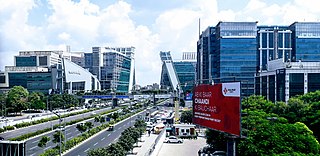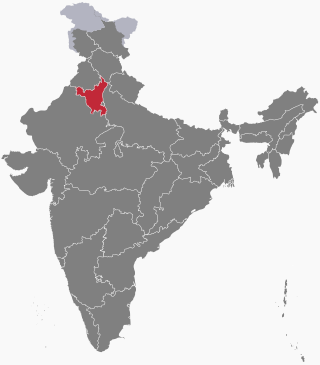Related Research Articles

Haryana is an Indian state located in the northern part of the country. It was carved out after the linguistic reorganisation of Punjab on 1 November 1966. It is ranked 21st in terms of area, with less than 1.4% of India's land area. The state capital is Chandigarh, which it shares with the neighbouring state of Punjab; the most populous city is Faridabad, a part of the National Capital Region. The city of Gurgaon is among India's largest financial and technology hubs. Haryana has 6 administrative divisions, 22 districts, 72 sub-divisions, 93 revenue tehsils, 50 sub-tehsils, 140 community development blocks, 154 cities and towns, 7,356 villages, and 6,222 villages panchayats.

Hisar also known as Hissar is the administrative headquarters of Hisar district in the state of Haryana in northwestern India. It is located 164 km (102 mi) to the west of New Delhi, India's capital, and has been identified as a counter-magnet city for the National Capital Region to develop as an alternative center of growth to Delhi.

The Central Arid Zone Research Institute (CAZRI) is one of the biggest research institutes of the Indian Council of Agricultural Research (ICAR), an autonomous organization working under the aegis of the Department of Agriculture Research and Education (DARE) of the Ministry of Agriculture and Farmers Welfare of Government of India. CAZRI has the distinction of being one of the first institutes in the world exclusively devoted to arid zone research and development. The institute made a humble beginning in 1952 when Government of India initiated Desert Afforestation Research Station at Jodhpur to carry out research on sand dune stabilization and for establishment of shelter belt plantations to arrest wind erosion. It was reorganized as Desert Afforestation and Soil Conservation Station in 1957 and finally in its present form Central Arid Zone Research Institute in 1959 on recommendation of the UNESCO (United Nations Educational, Scientific and Cultural Organization) expert, Prof. C.S. Christian of the Commonwealth Scientific and Industrial Research Organisation (CSIRO), Australia. In 1966, the institute was brought under the administrative control of Indian Council of Agricultural Research (ICAR), New Delhi.

The Murrah buffalo is a breed of water buffalo mainly kept for milk production. It originates in Haryana and Punjab of India, where it is kept in the districts of Bhiwani, Agra, Hisar, Rohtak, Jind, Jhajhar, Fatehabad, Gurgaon and the capital region of Delhi. It has been used to improve the milk production of dairy buffalo in other countries, such as Italy, Bulgaria and Egypt. A Murrah buffalo at the Lakshmi Dairy Farm in Punjab set a record of 26.335 kg (58.06 lb) of milk in the 2016 National Livestock Competition and Expo. In Brazil, this breed of buffalo is used for production of both meat and milk. Murrahs sell for a high price.

Chaudhary Charan Singh Haryana Agricultural University is a public funded agricultural university located at Hisar in the Indian state of Haryana. It is the biggest agricultural university in Asia. The university has 8,645 acres (3,499 ha) of land. It is named after India's fifth Prime Minister, Chaudhary Charan Singh. It was ranked 7th in India by the National Institutional Ranking Framework in the agriculture and allied sector ranking for 2024.

GSDP of Haryana state is estimated to be US$140 billion in 2023-2034 which had grown at 12.96% CAGR between 2012–17, boosted by the fact that this state on DMIC in NCR contributes 7% of India's agricultural exports and 60% of India's Basmati rice export, with 7 operational SEZs and additional 23 formally approved SEZs. Haryana also produces India's 67% of passenger cars, 60% of motorcycles, 50% of tractors and 50% of the refrigerators, which places Haryana on 14th place on the list of Indian states and union territories by GDP behind only much bigger states that are significantly larger in both area and population.

The Haryana Pradesh Congress Committee or is the state unit of the Indian National Congress (INC) in the state of Haryana, India. It is responsible for organizing and coordinating the party's activities and campaigns within the state, as well as selecting candidates for local, state, and national elections. The HPCC's headquarters are located in Chandigarh. The current president of the Haryana Pradesh Congress Committee is Mr. Udai Bhan, a senior leader and four-time Member of the Legislative Assembly (MLA).

The following outline is provided as an overview of and topical guide to Haryana.
Hisar Airport, officially known as Maharaja Agrasen International Airport is a DGCA-licensed public airport serving Hisar in Haryana state of India. It is located 5 kilometres (3.1 mi) northeast of the city center on NH-9. The airport is planned to be upgraded to an international airport by 2030. It will eventually see the development of a new MRO, aerospace university, aerospace and defense manufacturing industrial zone, logistics and food parks, etc. over an area spread across 10,000 acres (4,000 ha). In 2021, the total cost of planned upgrade in 3 phases, including the actual spend and future approved allocations, is nearly ₹5,200 crore.

Irrigation in India includes a network of major and minor canals from Indian rivers, groundwater well based systems, tanks, and other rainwater harvesting projects for agricultural activities. Of these groundwater system is the largest. In 2013–14, only about 36.7% of total agricultural land in India was reliably irrigated, and remaining 2/3 cultivated land in India is dependent on monsoons. 65% of the irrigation in India is from groundwater. Currently about 51% of the agricultural area cultivating food grains is covered by irrigation. The rest of the area is dependent on rainfall which is most of the times unreliable and unpredictable.

The Central Institute of Agricultural Engineering (CIAE) is a higher seat of learning, research and development in the field of agricultural engineering, situated in the lake city of Bhopal, Madhya Pradesh, India. It is an autonomous body, an Indian Council of Agricultural Research subsidiary, under the Ministry of Agriculture & Farmer's Welfare, Government of India.
The Central Soil Salinity Research Institute (CSSRI) is an autonomous institute of higher learning, established under the umbrella of Indian Council of Agricultural Research (ICAR) by the Ministry of Agriculture, Government of India for advanced research in the field of soil sciences. The institute is located on Kachawa Road in Karnal, in the state of Haryana, 125 km (78 mi) from the Indian capital of New Delhi.
Central Sheep Breeding Farm, Hisar is a public funded agricultural research, breeding and education institute located at Hisar in the Indian state of Haryana that offers educational courses in Shearing Training and Sheep Management & Production Training.
Central Institute for Research on Buffaloes, Hisar, a publicly funded, institute for water buffalo research. It is located 170 kilometres (110 mi) from Delhi, at Hisar in the north Indian state of Haryana. It has a sub-campus, Bir Dosanjh, at Nabha. CIRB operates a nationwide network of 10 research centres working on breed improvement of the 7 main native breeds. CIRB, with over 20 laboratories for buffalo research, is the world's largest buffalo research institute with the widest range of breeds under study. With the aim of improving breeds and dissemination of information, CIRB has sold over 1,000 bulls, conducted ~200,000 artificial insemination in the field for the farmers' buffaloes with a 41% conception rate, distributed ~520,000 progeny tested frozen semen kits to 45,000 farmers and over 250 institutes, imparted training to several thousand farmers on advanced buffalo husbandry, and created the world's first online Buffalopedia in several languages. It has a large research partner network across India and the globe. It is the second institute to successfully clone a buffalo in 2016, after the first successful cloning was achieved by the National Dairy Research Institute, Karnal in 2010. In July 2017, the Indian Council of Agricultural Research ranked CIRB Hisar as India's number one Buffalo research institute for the year 2016–17.
Regional Fodder Station, Hisar is a public funded agricultural research and training institute located at Sirsa road, Hisar in the Indian state of Haryana for fodder research and training.
The minimum support price (MSP) is the minimum price for select crops raised in kharif and rabi seasons that the Government of India considers as remunerative for farmers and hence deserves support. This is different from procurement price and issue price. It is generally announced before the sowing/planting season. It is approved by the government and aims to safeguard the farmer to a minimum profit for the harvest while at the same time increasing food security in the country. MSP was initially an incentive for farmers to adopt technology with an aim of increasing the productivity of agricultural land in the 1960s, however in the 2000s it is seen as a market intervention and farmer income scheme. The effectiveness of such a price policy has varied widely between states and commodities. Awareness among farmers of the existence of an MSP is poor at 23%, while awareness of MSP procurement agencies is also poor with only about 20–25% of wheat and paddy produce being sold at MSP.
Samyukta Kisan Morcha (SKM), formed in November 2020, is a coalition of over forty Indian farmers' unions to coordinate satyagragh against the three farm acts initiated in September of the same year.
References
- 1 2 S. M. Jharwal, R. S. Deshpande, Vijay Paul Sharma, Brajesh Jha, S. A. Ansari, R. P. S. Malik 2007, "Glimpses of Indian Agriculture: Two Volumes, Three Parts", Agro-Economic Research Centre, Ministry of Agriculture & Farmers Welfare, Page 545, ISBN 8171885977.
- 1 2 3 4 5 Annual Report 2014-15, NRFMTTI.
- 1 2 3 Annual Report 2013-14, NRFMTTI.
- 1 2 "Farm tech", Ministry of Agriculture, Govt of India.
- 1 2 "NRFMTTI, Hisar" Archived 16 September 2011 at the Wayback Machine , Govt. of India Department of Technology.
- 1 2 "NRFMTTI", Govt of India.
- 1 2 "Status of farm machinery testing in India", United Nations Economic and Social Commission for Asia and the Pacific.
